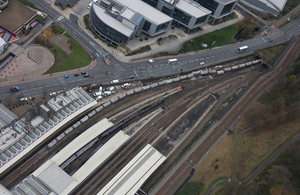Freight train derailment at Sheffield station
Investigation into a freight train derailment at Sheffield station, South Yorkshire, 11 November 2020.

The train following the derailment (image courtesy of Network Rail Air Operations Team)
At about 02:45 hrs on 11 November 2020, a freight train conveying 34 wagons loaded with cement powder derailed as it was passing through Sheffield station at around 12 mph (19 km/h). The train was travelling from Hope cement works in Derbyshire to Dewsbury cement terminal in West Yorkshire.
A total of 16 wagons derailed after passing the north end of Platform 1. The leading ten wagons and the rear eight wagons remained on the track. One of the derailed wagons tipped onto its side and spilled some of its cargo onto the track.
The train brake pipe started to leak as the wagons derailed, resulting in a gradual application of the brakes. The driver saw the brake pipe pressure gauge dropping and applied the train brake, thus stopping the train. This coincided with the signaller making an immediate ‘stop all trains’ emergency call to trains in the station area after becoming aware of multiple track and signalling failures.
RAIB’s preliminary examination found that a series of rail fastenings, intended to maintain the correct distance between the rails, had broken. Initial evidence suggests that some of these were already broken before the derailment. Consequently, as the freight train passed, the rails moved apart and some of the wagons’ wheels dropped into the space between the rails.
Train services were disrupted for several days while the wagons were recovered and the consequent track damage repaired.
Our investigation will seek to identify the sequence of events which led to the accident. It will also consider any factors relevant to the design and maintenance of both the track and the wagons involved, how the risk of derailment was controlled at this location and any relevant underlying factors.
Our investigation is independent of any investigation by the railway industry or by the industry’s regulator, the Office of Rail and Road.
We will publish our findings, including any recommendations to improve safety, at the conclusion of our investigation. This report will be available on our website.
You can subscribe to automated emails notifying you when we publish our reports.